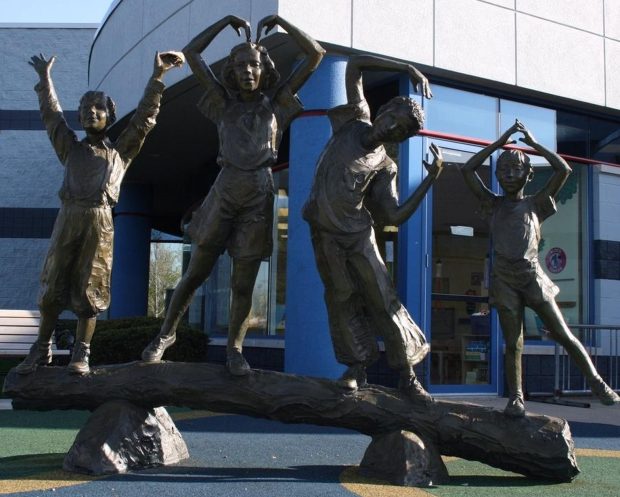Naperville is charting a new path forward for how public art in town is created and maintained.
Rather than relying on outside support to commission and manage public art in the city, which is what Naperville has done for more than two decades, the process will become the responsibility of a public-private partnership.
Early plans for the reinvigorated program were laid out Tuesday at a meeting of the city’s Special Events and Community Arts Commission (SECA).
Though still in the preliminary stages, the idea is to establish a partnership with a nonprofit organization that would help the city solicit new public art projects.
Those behind the proposal — a mix of representatives from the city and art-minded community members — emphasized the public-private arrangement wouldn’t be an overhaul of the existing public art program but a way of building onto what’s already been done.
For the past 27 years, the task of soliciting and producing murals, sculptures, mosaics, fountains and other art pieces in Naperville has been the work of local nonprofit Century Walk Corp.
Century Walk’s work is visible all around the city. The Cat in the Hat sculpture outside Nichols Library, the many art installations along the Naperville Riverwalk and the murals that adorn the facades of many downtown buildings and structures were all commissioned by the group.
A new way of doing things, however, has been building for some time.
In 2020, despite Century Walk’s long tenure, concerns arose over whether a more diverse group would better serve the community. The city started to develop its own public arts program under the auspices of SECA.
Meanwhile, the city’s relationship with Century Walk began to strain as the nonprofit, which has relied on city funding and private donations since its inception in 1996, started imploring the city for more financial support.
Changes came to a head in March when longtime Century Walk President Brand Bobosky announced he would be retiring by year’s end, putting the future of the nonprofit — and Naperville’s public art scene — into question.
Despite initiating its own public art program under SECA, the city initiative still didn’t have a clear direction or vision when Bobosky made his announcement, City Clerk Dawn Portner, previously Naperville’s special events coordinator, said at the meeting Tuesday.
Needing a roadmap, a steering committee composed of Portner, Deputy City Manager Pam Gallahue, several SECA commissioners and a local stakeholder came together to draw up a plan. In consultation with the city, the committee decided that a public-private partnership would be the best course of action, Portner said.
The idea was inspired by what the city has had for years with Naperville Development Partnership. A public-private economic development organization, the partnership receives city funding but returns the investment by promoting local business interests.
Steering committee members envisioned a similar relationship for the benefit of public art and compiled a small working group of community members experienced in the arts to bring the idea to fruition.
That group has been meeting regularly since July and as of this week’s SECA meeting, was in the process of formally establishing a partnering public art organization for the city, according to SECA Commissioner Shannon Greene Robb, who doubles as a steering committee member.
Once the organization — which will be formed as a 501(c) nonprofit — is up and running, the goal is that it be the group to which artists, businesses and community members go to solicit and generate new public art in Naperville, Greene Robb said in an interview after Tuesday’s meeting.
To see projects through, she said, the nonprofit will go to the city for financial support. But the benefit of being an independent body is it can capitalize on grants and other funding opportunities that the city wouldn’t be able to apply for if the program was kept in house.
As the plan comes together, the city will be trying to gauge what residents want to see come out of the partnership. Starting Oct. 1, a public art survey will be done throught Oct. 31.
Speaking after the meeting, Portner said, “It’s kind of (to gauge) what people think about public art. Would you like to see more murals? More temporary art?”
The hope is that results will lay out a vision for the future, she said.
The one question that remains unanswered is: What about Century Walk?
Its legacy will live on, Portner said. The city is committed to funding maintenance for the 50-plus public art pieces commissioned by the group over the years, she said. Portner will be seeking $75,000 in the 2025 city budget to pay for updates needed on existing art and city maintenance will continue annually into the foreseeable future.
As for the Century Walk, it seems its days may be numbered.
Reached by phone Wednesday, Bobosky sais he doesn’t expect the organization to continue “unless there’s some kind of reversal in this decision to start a new (organization) and do all of this from scratch.”
“We’d be competing,” he said. “I’m not going to be here to do it, and I don’t think anybody else is going to want to do it.”

Bobosky said he didn’t understand the city’s decision to move beyond Century Walk and pursue a new kind of public art partnership, noting “because I’m leaving, everything has to change? I’m having trouble understanding that.” Still, he’s “certainly not going to stand in the way” of the revamped program, he said.
But he did caution prudence on the city’s part as it starts down this new path.
“We’re at a crossroads,” he said. “The question is, what’s the future? So let’s really find out what that future (should be). … We don’t have to rush on this.”
Portner wants to see Bobosky involved in the transition to some degree, she said.
“He’s got a lot to offer and he’s given a lot to the city,” she said. “We’re very respectful of that.”



